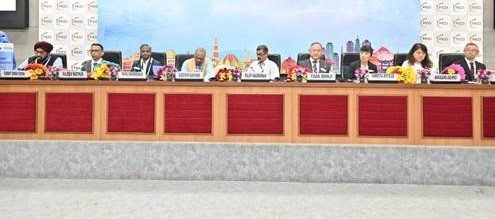
Mandaviya Invites Japanese Medical Device Initiative by India

The recent news of Union Health Minister Mansukh Mandaviya inviting Japanese medical device initiatives to India underscores India’s commitment to becoming a global hub for medical device manufacturing and innovation. This initiative highlights the growing collaboration between India and Japan in the healthcare and medical technology sectors.
Key Highlights of the Invitation:
- Strengthening India-Japan Ties in Healthcare:
- Minister Mandaviya emphasized the potential for deepening collaboration between India and Japan in the medical devices sector. The invitation was extended to Japanese companies to invest in India’s growing medical device market, citing opportunities for joint ventures, research & development (R&D), and technology transfer.
- The invitation was also in line with India’s broader goal of enhancing its healthcare infrastructure and manufacturing capabilities, and positioning the country as a manufacturing hub for medical devices.
- Opportunities in the Indian Market:
- India offers a rapidly expanding healthcare market driven by factors like increasing demand for advanced medical devices, a growing population, and the rise of chronic diseases. The Indian government is aiming to reduce dependency on imports, especially in critical areas like diagnostic devices, implants, and surgical instruments.
- FDI (Foreign Direct Investment) is encouraged in the medical device sector, and Japan’s experience and technological prowess in manufacturing cutting-edge medical equipment make it an ideal partner for India.
- India’s Medical Device Industry Focus:
- India is focusing on self-reliance in the medical devices sector through initiatives like the Production Linked Incentive (PLI) Scheme and the establishment of medical device parks across the country. These efforts aim to boost local manufacturing and reduce the reliance on imports, especially from countries like China and the U.S.
- The National Medical Device Policy (2023) was highlighted during the invitation, with the government setting out to make India a hub for medical device manufacturing and exports. The policy also focuses on innovation, regulation, quality control, and improving access to affordable healthcare products.
- Technological and Research Collaboration:
- Mandaviya encouraged Japanese companies to set up R&D centers in India, particularly to develop technologies for affordable healthcare solutions. Collaborative R&D between India and Japan could lead to innovations that cater specifically to the needs of India’s diverse population.
- Areas such as smart medical devices, telemedicine, and medical robotics were emphasized as potential areas for cooperation, where Japanese expertise can be leveraged to meet the demands of the Indian market.
- Indian Government Support for Foreign Investments:
- The Indian government is providing a range of incentives for foreign investments in the medical device sector, including tax breaks, infrastructure support, and simplified regulatory frameworks to attract global players. This has been facilitated through the Make in India and Atma Nirbhar Bharat initiatives.
- The Medical Device Parks being set up across the country are a key part of this strategy. These parks provide state-of-the-art infrastructure for medical device manufacturers and are designed to reduce the overall cost of production.
- Focus on Sustainability and Innovation:
- There is a growing emphasis on sustainability in the medical device industry, and Mandaviya highlighted the importance of adopting green technologies and eco-friendly manufacturing practices. Japanese companies, known for their advanced technology in electronics and sustainability practices, can play a critical role in this transformation.
- Innovation in medical devices that address both global and local healthcare challenges, such as affordable diagnostics, wearable health monitors, and portable healthcare equipment, will be a major area of focus in the partnership.
- Potential Areas for Japanese Companies to Explore:
- Diagnostic Equipment: India’s healthcare sector is witnessing an increase in the demand for diagnostic equipment, from basic medical imaging tools to advanced diagnostic systems. Japan’s leading-edge diagnostic devices could meet these demands.
- Implants and Prosthetics: India has a large population of people who require implants, including orthopedic and dental implants. There is a growing demand for high-quality, cost-effective prosthetics that Japanese companies could supply.
- Surgical Instruments: India imports a significant number of surgical instruments. Japan, with its advanced manufacturing techniques, could be an ideal partner for producing high-quality, precision surgical tools.
Significance of the Initiative:
- The partnership between India and Japan in the medical device sector represents a critical step in strengthening India’s healthcare infrastructure. This collaboration has the potential to bring about technological advancements, job creation, and increased investment in India’s healthcare ecosystem.
- For Japan, the partnership offers an opportunity to expand its market footprint in India, particularly in a sector that is poised for rapid growth. Additionally, Japan’s reputation for high-quality medical technology aligns well with India’s growing need for innovative, affordable, and accessible healthcare solutions.




























